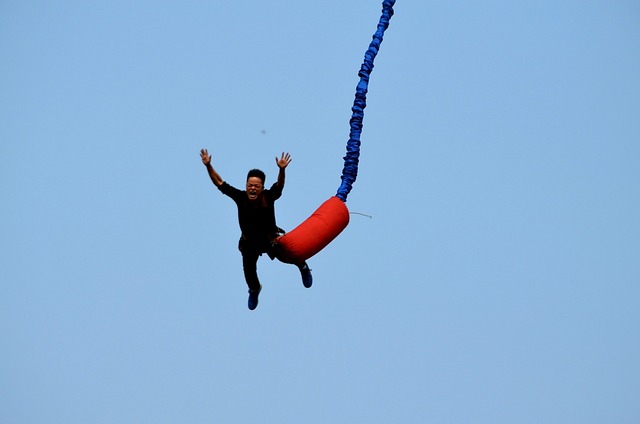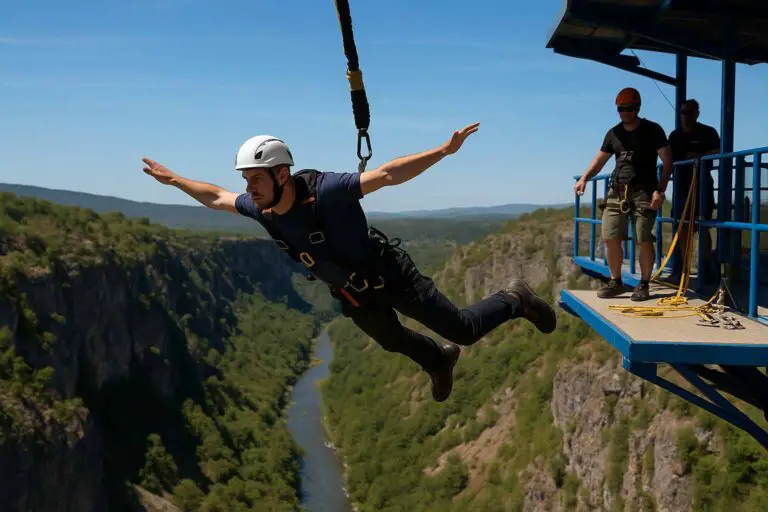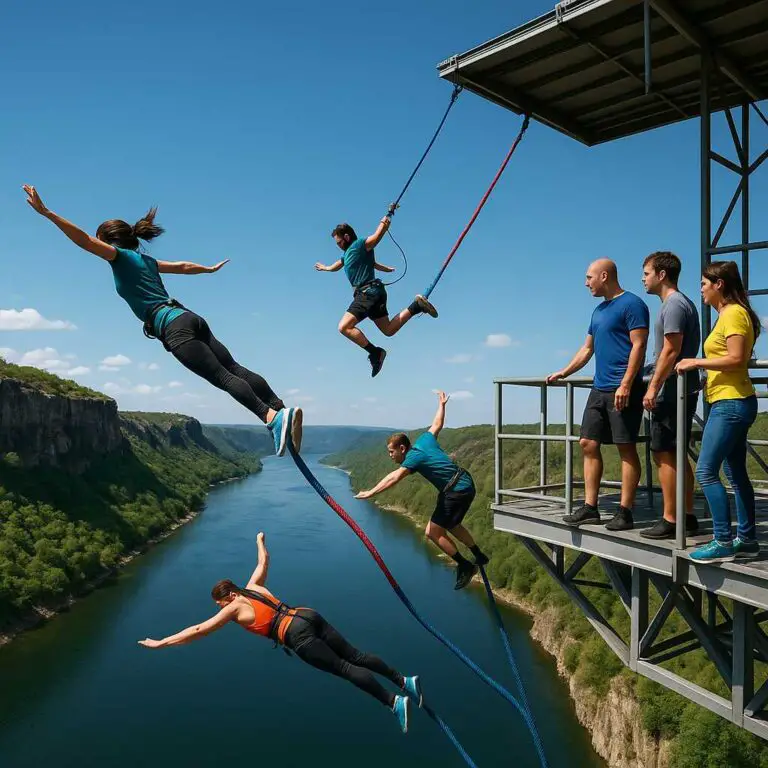As someone who has taken the plunge myself, I can vouch for the exhilaration that comes with leaping off a bridge or platform, suspended only by a bungee cord. However, I also understand the hesitations and concerns surrounding this daring activity, especially when it comes to safety. Bungee jumping death rate is relatively low. Reputable operators and stringent safety measures have contributed to minimizing risks. Accurate statistics may vary by location, but overall, bungee jumping is considered a reasonably safe adventure sport when conducted responsibly.
However, it’s essential to remember that all adventure activities carry inherent risks, and participants should prioritize safety by choosing reliable operators and following all instructions. For the most up-to-date statistics, it’s advisable to consult reputable sources and regulatory bodies.
In this article, I’m going to dive deep into the topic of bungee jumping, exploring everything from its origins to the factors that influence its safety. My primary focus will be on debunking the myths and misconceptions surrounding the bungee jumping death rate.
If you’ve ever wondered whether bungee jumping is a dangerous endeavor or just an unfairly stigmatized thrill, keep reading. Whether you’re a seasoned bungee jumper or a curious first-timer, this article aims to provide you with valuable insights and actionable tips to ensure your next bungee jump is both thrilling and safe.
Let’s take a leap into the topic of bungee jumping and separate fact from fiction.
What is Bungee Jumping?
Bungee jumping is an exhilarating adventure sport that involves leaping from a high platform, bridge, or any other tall structure while being connected to a strong, elastic cord (the bungee cord) that is securely tied around your ankles or waist. The basic principle of bungee jumping relies on the elastic properties of the cord, which stretches and recoils, allowing the jumper to experience a free-fall sensation before the cord brings them to a gentle, bouncing stop just above the ground or water below.
This adrenaline-pumping activity is not only about conquering fear but also about experiencing an intense rush of emotions as you temporarily defy gravity and surrender yourself to the forces of nature. Bungee jumping is often considered a thrilling way to test your courage and push the boundaries of what you thought was possible.
The origins of bungee jumping can be traced back to the land divers of Pentecost Island in Vanuatu, who used vines to jump from tall wooden platforms as a ritual to ensure a bountiful yam harvest. However, the modern commercial version of bungee jumping as we know it today was popularized in the late 20th century.
Today, bungee jumping has gained immense popularity worldwide, with numerous locations offering this heart-racing experience to adventure seekers. Each jump is an opportunity to experience the ultimate mix of fear, excitement, and the sense of accomplishment that comes from overcoming your apprehensions.
While bungee jumping is undoubtedly thrilling, it’s essential to remember that safety should always be the top priority. Reputable bungee jumping operators adhere to strict safety regulations and use high-quality equipment to ensure that participants can enjoy this adventure sport with minimal risk. So, if you’re ready to take the leap of a lifetime, let’s explore the safety measures and statistics that will help put your mind at ease and make your bungee jumping experience one for the books!
Addressing Safety Concerns
Safety is paramount when it comes to bungee jumping, and it’s completely natural to have concerns about the risks involved in this daring activity. However, the good news is that the bungee jumping industry takes safety very seriously, and there are stringent measures in place to minimize potential hazards. Let’s delve into the key aspects of addressing safety concerns in bungee jumping:
- Regulations and Standards: Bungee jumping operators are typically regulated by local or national authorities to ensure they adhere to specific safety standards. These regulations cover factors such as the construction and maintenance of jump platforms, the quality and inspection of bungee cords and harnesses, the qualifications of the staff, and emergency protocols. Always choose a bungee jumping company that is licensed and follows all the necessary safety guidelines.
- Equipment and Inspection: The equipment used in bungee jumping is specially designed to handle the immense forces involved in the activity. Bungee cords are made of strong, durable materials with high elasticity, and they undergo rigorous testing to ensure their integrity. Additionally, harnesses and other gear should be regularly inspected and replaced if any signs of wear or damage are detected.
- Case Studies: Learning from past incidents can provide valuable insights into improving safety measures. Reputable bungee jumping operators analyze any accidents that may have occurred and implement changes to prevent similar incidents in the future. Such learnings contribute to the continuous improvement of safety protocols within the industry.
It’s crucial to remember that while bungee jumping is thrilling, it involves calculated risks. However, the statistics show that the overall injury rate for bungee jumping is relatively low when compared to other adventure sports. Most accidents are attributed to human error, lack of proper equipment inspection, or adverse weather conditions.
To further alleviate safety concerns, it’s essential to follow all instructions provided by the trained staff. They will guide you through the entire process, ensuring you are properly harnessed and briefed on the correct jumping technique. Listen carefully and ask questions if anything is unclear – their expertise is there to guarantee your safety and enjoyment.
Ultimately, bungee jumping can be a safe and unforgettable experience when conducted by reputable operators who prioritize safety above all else. So, if you’ve got a thrill for adventure, rest assured that you can take the leap with confidence, knowing that you are in good hands. Let’s continue with this journey to unravel the truth about the bungee jumping death rate and understand the statistics behind this thrilling activity.
Analyzing the Bungee Jumping Death Rate
Analyzing the bungee jumping death rate is essential to gain a clear understanding of the safety of this thrilling activity. Let’s delve into the data and debunk any misconceptions surrounding the risks involved in bungee jumping:
- Understanding Statistics and Data Sources: Accurate data on bungee jumping accidents is crucial for a comprehensive analysis. However, it’s essential to be critical of the sources and consider the context of the data. Reputable bungee jumping operators maintain records of incidents, and government regulatory bodies often compile statistics to monitor safety standards. By relying on official and reliable sources, we can avoid exaggerations and get a more accurate picture.
- Differentiating between Accident Causes: It’s essential to distinguish between accidents caused by equipment failure and those resulting from human error. In most cases, accidents are attributed to human mistakes, such as miscalculations in rope length or incorrect harness fitting. Reputable operators invest in thorough training for their staff to reduce the likelihood of these errors.
- Debunking Myths: Is Bungee Jumping Really Dangerous? The perception of danger associated with bungee jumping is often amplified due to sensationalized media reports and misconceptions. While there have been unfortunate incidents, the overall fatality rate for bungee jumping is relatively low when compared to other adventure sports like skydiving or rock climbing.
It’s crucial to recognize that just like any adventurous activity, bungee jumping carries inherent risks. However, by choosing a well-established and safety-focused operator and following all instructions, you can significantly reduce those risks.
Moreover, advancements in bungee jumping equipment and safety measures over the years have further enhanced the safety of the sport. Reputable operators use high-quality bungee cords, regularly inspect all equipment, and maintain strict safety protocols to ensure a safe and enjoyable experience for all participants.
As you continue reading, it’s vital to remember that while the death rate is an essential aspect to consider, it’s not the sole indicator of safety. The overall injury rate and adherence to safety standards are equally crucial factors.
Now, let’s uncover the factors that can influence bungee jumping safety and learn how to prepare for a safe and unforgettable leap.
Factors Influencing Bungee Jumping Safety
Bungee jumping safety is influenced by several key factors that play a crucial role in ensuring a thrilling yet secure experience. Understanding these factors can help participants make informed decisions and enhance the overall safety of the activity. Let’s explore the primary factors that influence bungee jumping safety:
- The Importance of Location and Environment:
- Choosing the right location for bungee jumping is vital. Operators often select natural or man-made structures that meet specific safety criteria, such as bridges, towers, or purpose-built platforms. The site should be free from potential hazards and offer ample space for safe landings.
- The surrounding environment, including water bodies or open areas, is considered to ensure the jumper’s safety in case of any unexpected occurrences during the jump.
- Weather Conditions:
- Weather plays a significant role in bungee jumping safety. High winds, heavy rain, or extreme temperatures can affect the stability of the jump platform or the behavior of the bungee cord. Therefore, operators closely monitor weather forecasts and may postpone or cancel jumps if conditions are deemed unsafe.
- Participant Health:
- Bungee jumping is physically demanding, and participants need to be in reasonably good health to handle the stress on their bodies during the jump. Individuals with heart conditions, back problems, or other health concerns may be advised against bungee jumping.
- Before participating, participants typically fill out a health questionnaire to identify any potential risk factors that could affect their safety during the jump.
- Equipment Quality and Inspection:
- High-quality and well-maintained equipment are fundamental to bungee jumping safety. Reputable operators invest in top-grade bungee cords, harnesses, and other safety gear that undergo regular inspection and maintenance.
- Operators follow strict protocols to check and test equipment before each jump, ensuring that it meets safety standards.
- Operator Experience and Training:
- The competence of the bungee jumping operator and staff significantly impacts the safety of the experience. Well-trained and experienced personnel are better equipped to handle emergency situations and ensure a smooth and secure jump.
- Operators with a long-standing reputation and a history of safe operations are more likely to prioritize safety above all else.
- Weight and Height Limitations:
- Bungee jumping has weight and height restrictions to ensure that the bungee cord is properly calibrated for each jumper’s size. These limitations help prevent overstretching or understretching of the cord, which could compromise safety.
By taking all these factors into account, bungee jumping operators strive to create an environment where participants can have an unforgettable adventure while minimizing risks. As potential bungee jumpers, it’s essential to be aware of these safety considerations and choose a reputable operator that prioritizes your well-being throughout the entire experience. With the right precautions and safety measures in place, bungee jumping can offer an unparalleled rush of excitement and a truly unforgettable moment in your life.
Tips for a Safe and Thrilling Bungee Jump
Absolutely! Bungee jumping can be a heart-pounding and exhilarating adventure, but ensuring your safety is of utmost importance. Here are 10 essential tips to make your bungee jump a safe and thrilling experience:
- Choose a Reputable Bungee Jumping Operator:
- Research and select a well-established and reputable bungee jumping operator. Look for reviews and testimonials from previous participants to gauge the operator’s safety record and customer satisfaction.
- Follow Pre-Jump Instructions Carefully:
- Pay close attention during the pre-jump briefing. Listen to the instructions provided by the experienced staff and follow them meticulously. This will ensure you are properly harnessed and prepared for the jump.
- Mental Preparation:
- Bungee jumping can be a nerve-wracking experience, especially for first-timers. Take some time to mentally prepare yourself before the jump. Remind yourself of the safety measures in place and focus on the thrilling aspect of the experience.
- Wear Proper Attire:
- Dress comfortably and appropriately for the weather conditions. Avoid loose clothing or accessories that could become entangled during the jump. Wear closed-toe shoes with good grip for a stable landing.
- Check Harness and Gear:
- Before jumping, ensure that your harness and all gear are properly fitted and secure. Confirm that the bungee cord is attached correctly to your harness and the jump platform.
- Know Your Health Limitations:
- Be honest about any pre-existing health conditions that might affect your ability to safely participate in bungee jumping. Consult with your healthcare provider if you have any concerns.
- Stay Hydrated and Eat Lightly:
- Stay hydrated before the jump, but avoid consuming heavy meals immediately beforehand. A light meal or snack will provide energy without causing discomfort during the jump.
- Listen to Staff during the Jump:
- As you prepare for the jump, listen carefully to the instructions given by the staff. They will guide you on when and how to jump, ensuring that you have the best and safest experience.
- Embrace the Experience:
- Once you take the leap, enjoy the exhilarating free-fall and the subsequent rebound. Let go of any fear and embrace the moment, knowing that you are in safe hands.
- Trust the Equipment and Safety Measures:
- Remember that bungee jumping equipment is designed to withstand the forces involved. Trust in the expertise of the operators and the quality of the gear provided.
Remember, bungee jumping is an adventure that combines both excitement and safety, allowing you to create memories that will last a lifetime.
Comparing Bungee Jumping with Other Adventure Activities
Bungee jumping is just one of many exhilarating adventure activities available to thrill-seekers. Let’s compare bungee jumping with some other popular adventure sports to understand the relative risks and rewards:
-
Skydiving:
- Similar to bungee jumping, skydiving offers an adrenaline-pumping free-fall experience. However, skydiving involves jumping from an airplane at high altitudes, while bungee jumping involves leaping from a fixed structure.
- In skydiving, you experience the sensation of flying through the air, whereas bungee jumping offers the unique rebounding effect of the bungee cord.
- Skydiving typically requires more extensive training and certification, whereas bungee jumping can be done with a brief pre-jump briefing.
-
Rock Climbing:
- Rock climbing is a physically demanding adventure sport that involves ascending natural or artificial rock formations using ropes and specialized equipment.
- Unlike the quick thrill of bungee jumping, rock climbing is a more prolonged and challenging activity that requires technical skills and endurance.
- While rock climbing can be riskier in terms of potential falls and injuries, proper training and safety measures significantly reduce the hazards.
-
Whitewater Rafting:
- Whitewater rafting is an exciting water sport that involves navigating rapids in an inflatable raft.
- Rafting offers a more communal and team-oriented adventure, as you navigate the river with a group of fellow participants and a skilled guide.
- While whitewater rafting does involve risks associated with water activities, wearing proper safety gear and following the guide’s instructions ensure a safe experience.
-
Paragliding:
- Paragliding allows you to soar like a bird, using a parachute-like wing to glide through the air.
- Compared to the quick intensity of bungee jumping, paragliding offers a more peaceful and extended flight experience.
- Paragliding requires training and an understanding of wind conditions, but with proper guidance, it can be a relatively safe activity.
It’s essential to recognize that all adventure sports carry inherent risks, but each also offers its unique thrills and rewards. The level of risk varies based on factors such as operator experience, safety protocols, and the participant’s preparedness. Reputable operators in all adventure activities prioritize safety and provide proper equipment and guidance to minimize potential hazards.
Ultimately, the choice between bungee jumping and other adventure sports comes down to personal preferences and comfort levels. Whether you seek the quick rush of bungee jumping, the thrill of free-falling in the sky, or the challenge of scaling a rock face, remember to prioritize safety and enjoy every moment of these incredible experiences.
The Evolution of Bungee Jumping Safety Measures
The evolution of bungee jumping safety measures has been a significant factor in making this thrilling adventure sport safer and more accessible to a broader audience. Over the years, advancements in equipment, regulations, and operator practices have played a crucial role in enhancing safety standards. Let’s take a look at the key milestones in the evolution of bungee jumping safety measures:
- Pioneering Safety Protocols:
- When bungee jumping emerged as a commercial activity in the late 20th century, safety protocols were still in their infancy. The early days of bungee jumping were marked by a more informal approach to safety, with limited regulations and standardization.
- Equipment Innovations:
- As the popularity of bungee jumping grew, so did the demand for safer and more reliable equipment. Manufacturers began developing specialized bungee cords with increased elasticity and durability to withstand the forces involved in the jumps.
- Improved harness designs were introduced, providing a more secure and comfortable fit for jumpers.
- Implementation of Regulations:
- Governments and regulatory bodies recognized the need to ensure the safety of participants in this high-risk activity. Regulations and safety standards specific to bungee jumping were gradually introduced in various regions, helping to formalize the industry and set safety benchmarks.
- Operator Training and Certification:
- Training and certification programs for bungee jumping operators and staff became more widespread. This ensured that those involved in conducting jumps were well-trained and knowledgeable about safety procedures and emergency protocols.
- Regular Inspections and Maintenance:
- Reputable bungee jumping operators adopted a culture of regular equipment inspections and maintenance. Bungee cords, harnesses, and all other gear are thoroughly checked before each jump to identify any signs of wear or damage.
- Technological Advancements:
- Technological advancements, such as the use of high-definition cameras and drones, have facilitated more efficient monitoring of jumps. This allows operators to closely observe each jump and identify any safety concerns or areas for improvement.
- Enhanced Staff-to-Participant Ratio:
- Ensuring a sufficient number of qualified staff members per participant helps in providing individual attention and guidance throughout the jumping process. This enhances safety and minimizes the risk of human errors.
- Learning from Incidents:
- The bungee jumping industry has learned valuable lessons from past incidents. Each accident has led to a thorough investigation and analysis, resulting in revised safety protocols and improved practices.
- Public Awareness and Education:
- Public awareness campaigns and educational initiatives have played a role in promoting safe bungee jumping practices. Participants are encouraged to understand the risks, ask questions, and choose reputable operators.
Through these progressive measures, bungee jumping has evolved from an adrenaline-fueled novelty to a well-regulated and safety-conscious adventure sport. Today, thrill-seekers can experience the excitement of bungee jumping with confidence, knowing that their safety is prioritized by the operators. The continued commitment to safety and advancement in technology will undoubtedly pave the way for an even safer and more enjoyable bungee jumping experience in the future.
Real-Life Bungee Jumping Experiences from Enthusiasts
Real-life bungee jumping experiences from enthusiasts are a testament to the thrill and excitement that this adventure sport offers. Let’s hear some firsthand accounts from individuals who have taken the leap and experienced the adrenaline rush of bungee jumping:
- Sarah’s Leap of Courage: “I had always been fascinated by extreme sports, but bungee jumping was a whole new level of daring for me. When I stood on the edge of that platform, my heart was pounding, and fear was trying to take over. But the support of the friendly staff and the encouragement from my friends pushed me to take the leap. The feeling of free-falling and rebounding was indescribable! Bungee jumping taught me that sometimes, the best things in life are waiting for us just beyond our comfort zones.”
- Mike’s Bungee Jumping Adventure: “As an adrenaline junkie, I had tried various adventure sports, but bungee jumping was something I had to experience. The anticipation built as I was being harnessed, and my heart was racing when I looked down from the platform. When I finally jumped, the sensation of flying through the air was absolutely mind-blowing. It was an exhilarating moment of pure freedom and an incredible rush of adrenaline. Bungee jumping has become my all-time favorite adventure, and I can’t wait to do it again!”
- Emily’s Triumph over Fear: “I have always had a fear of heights, but I was determined to conquer it. Bungee jumping seemed like the ultimate challenge, and I decided to face my fear head-on. The whole experience was nerve-wracking, but the support of the experienced staff gave me the confidence I needed. When I finally jumped, the fear transformed into an overwhelming feeling of triumph. It was an empowering experience that taught me not to let fear hold me back. Bungee jumping was the catalyst for breaking barriers in my life.”
- John’s Adrenaline Adventure with Friends: “A group of us decided to try bungee jumping together, and it turned out to be the best decision ever. The excitement was contagious as we cheered each other on and exchanged nervous laughs. When it was my turn to jump, I took a deep breath and went for it. The thrill of the free-fall and the rebounding was an unforgettable rush, but what made it even better was sharing the experience with my friends. Bungee jumping brought us closer together, and we now have a memory that will bond us for a lifetime.”
These real-life experiences highlight the diverse range of emotions and personal growth that bungee jumping can offer. From conquering fears to finding empowerment and forming lasting connections with friends, bungee jumping is a life-changing adventure for many enthusiasts. Each jump is a unique and unforgettable experience that leaves participants with a sense of accomplishment and an unquenchable thirst for more adrenaline-fueled adventures!
Conclusion
In conclusion, bungee jumping is undeniably a thrilling adventure that captivates the hearts of adrenaline enthusiasts worldwide. Throughout this article, I have meticulously explored every aspect of bungee jumping, from its definition and safety concerns to the statistics and real-life experiences shared by brave enthusiasts.
Based on the evidence presented, it is evident that bungee jumping, when conducted by reputable operators and adhering to strict safety protocols, can be considered a relatively safe adventure sport. The evolution of bungee jumping safety measures, including advancements in equipment, regulations, and operator training, has significantly contributed to minimizing risks and ensuring the well-being of participants.
However, it is crucial to acknowledge that while bungee jumping safety has improved dramatically, it remains an activity that involves inherent risks. The exhilaration of bungee jumping comes from the element of danger, and participants must fully understand and accept these risks before taking the leap.
Choosing a reputable bungee jumping operator and following all safety instructions are imperative to enjoy this adventure safely. Engaging in open communication with operators, disclosing any health concerns, and seeking medical advice, if necessary, are all crucial steps in ensuring a secure experience.
The shared real-life experiences of enthusiasts serve as an inspiration, illustrating the transformative power of bungee jumping. These tales of courage, camaraderie, and personal growth reflect the profound impact this activity can have on individuals, pushing them to conquer fears and embrace life to the fullest.
As you consider embarking on a bungee jumping adventure, remember that preparation, responsible decision-making, and prioritizing safety should be your topmost concerns. Embrace the thrill, enjoy the rush, and create memories that will stay with you forever.
In the end, bungee jumping is an adventure that offers an exhilarating mix of excitement and fear – an extraordinary journey into the unknown. If you are ready to take the plunge, make sure to choose wisely, listen to the experts, and leap with confidence.
Related: Bungee Jump Age Limit: How Old Do You Have To Be To Bungee Jump?








